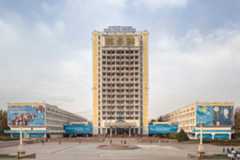Central Asia's Wild Soviet Architecture
When the Soviet Union broke up in the early 1990s, most of the newly independent republics that emerged from the wreckage wanted little to do with their old colonial master. But as the decades passed, nostalgia for the USSR took root in some of these former Soviet satellites. Few pine for a return of the KGB or thenomenklatura—whose blustering incompetence is devastatingly portrayed in HBO's current miniseriesChernobyl—but some older residents look back fondly on the days of guaranteed employment and housing.
In the cultural realm, such nostalgia often fastens onto Soviet architecture: the Brutalist-style concrete housing blocks, the grandly ostentatious government buildings, the vast public spaces festooned with heroic statuary. Although widely mocked, this triumphalist architecture does have its defenders. In Almaty, the former capital of Soviet Kazakhstan, a group of local architects founded a group called ArchCode to document and preserve the city's "architectural DNA," much of which is under threat of demolition. Similar groups have sprung up elsewhere in the former Soviet empire.
Italian photographersRoberto Conte andStefano Perego developed an interest in Soviet architecture while working on projects in Russia, Georgia, Armenia, and Belarus. For their new bookSoviet Asia: Soviet Modernist Architecture in Central Asia, published by Fuel Design, they traveled to the former Soviet republics of Kazakhstan, Kyrgyzstan, Uzbekistan, and Tajikistan. Through their photos, Conte and Perego want to puncture the idea that there is a single, monolithic Soviet architectural style.
"We think that Soviet architecturalstyles is more accurate," Conte says. "There were many currents that developed, from the Constructivism of the early Soviet Union to the symmetrical Neoclassicism of the Stalinist area, followed by Soviet Modernism. Each of these was interesting to us for different reasons."
Designed mostly by Moscow-trained architects, the buildings Conte and Perego photographed are all executed with a recognizably Soviet aesthetic, although many include touches inspired by local traditions. They found one of the richest collections of Soviet architecture in Tashkent, the capital of Uzbekistan, which was rebuilt by the USSR after being destroyed by a massive 1966 earthquake. It was here that they photographed their favorite building in the book, the colossalHotel Uzbekistan.
That hotel is still in service, as are most of the other buildings Conte and Perego photographed. But many are dilapidated, and renovation often requires transforming them beyond recognition. In some cases, the photographers arrived to photograph a building only to find that it had already been demolished. Slowly but surely, the USSR's architectural legacy is disappearing. What's left, they say, is worth fighting for.
"This architecture embodies the idea of modernity, but it was created by a country that no longer exists," Conte observes. "Each of the buildings proposed very creative solutions to practical needs—in most cases with a majestic and imposing result."
- A dystopian vision of the future:toxic but candy-sweet
- Can a test tell you which pills to popwith just a prick?
- What thecollege scandal shallowfakes say about the rich
- Melinda Gates to tech:Wake up to women's empowerment
- My wild ride ina robot race car
- 🎧 Things not sounding right? Check out our favoritewireless headphones,soundbars, andbluetooth speakers
- 📩 Want more?Sign up for our daily newsletter and never miss our latest and greatest stories


